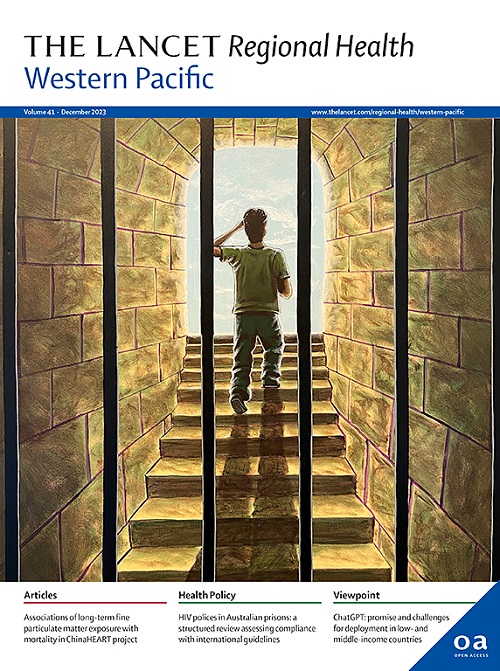A population-based study of cause-specific mortality in First Nations Australians with cirrhosis: impact of cardiometabolic comorbidities and liver disease risk factors
IF 8.1
1区 医学
Q1 HEALTH CARE SCIENCES & SERVICES
引用次数: 0
Abstract
Background
Liver disease is an important contributor to high mortality in First Nations Australians. We describe cause-specific mortality by First Nations status in people with cirrhosis.
Methods
Population-based retrospective cohort analysis of all adults with cirrhosis admitted to hospitals in the state of Queensland (2007–2022). Patients (1909 First Nations and 20,584 non-First Nations) were followed from the first admission with cirrhosis until date of death, liver transplant, or 31 December 2022, whichever came first. Multivariable Cox regression and Fine and Gray proportional subhazard models were used to assess differences in mortality according to First Nations status.
Findings
During a median follow-up of 6.9 years (IQR 3.5–11.1), 995 (52.1%) First Nations and 11,367 (55.2%) non-First Nations patients died. First Nations people died on average 9.4 years younger than non-First Nations Australians (57.0 years (SD = 12.1) vs 66.4 years (SD = 12.2), respectively). Approximately half of First Nations (48.9%) and non-First Nations (50.4%) deaths had liver disease as their underlying cause, and the 10-year liver-related mortality did not differ according to First Nations status (adjusted-sHR = 0.92, 95% CI 0.83–1.01). First Nations patients had a 1.6-fold increased risk of 10-year mortality due to cardiovascular disease (adjusted-sHR = 1.59, 95% CI 1.29–1.96), diabetes (adjusted-sHR = 1.60, 95% CI 1.07–1.52), and infections/parasitic diseases (adjusted-sHR = 1.61, 95% CI 1.12–2.23) vs non-First Nations patients.
Interpretation
Mortality due to cardiovascular disease, diabetes, and infections/parasitic diseases are 60% higher in First Nations Australians with cirrhosis. The higher non-liver disease mortality in First Nations Australians reinforces the need for a holistic approach to management of metabolic comorbidities in patients with cirrhosis.
Funding
This research did not receive any specific grant from funding agencies in the public, commercial, or not-for-profit sectors.
一项基于人群的澳大利亚原住民肝硬化患者死因特异性死亡率研究:心脏代谢合并症和肝脏疾病危险因素的影响
背景肝病是澳大利亚原住民高死亡率的一个重要因素。我们根据原住民身份描述肝硬化患者的死因特异性死亡率。方法对2007-2022年在昆士兰州住院的所有成年肝硬化患者进行基于人群的回顾性队列分析。患者(1909名原住民和20,584名非原住民)从首次入院肝硬化随访至死亡、肝移植或2022年12月31日,以先到者为准。采用多变量Cox回归和Fine和Gray比例亚危险模型来评估不同原住民身份的死亡率差异。在中位随访6.9年(IQR 3.5-11.1)期间,995例(52.1%)原住民患者和11367例(55.2%)非原住民患者死亡。第一民族的人比非第一民族的澳大利亚人平均年轻9.4岁(分别为57.0岁(SD = 12.1)和66.4岁(SD = 12.2))。大约一半的第一民族(48.9%)和非第一民族(50.4%)死亡的潜在原因是肝脏疾病,10年肝脏相关死亡率没有因第一民族身份而异(调整后shr = 0.92, 95% CI 0.83-1.01)。与非原住民患者相比,原住民患者因心血管疾病(调整后的shr = 1.59, 95% CI 1.29-1.96)、糖尿病(调整后的shr = 1.60, 95% CI 1.07-1.52)和感染/寄生虫病(调整后的shr = 1.61, 95% CI 1.12-2.23)导致的10年死亡率增加了1.6倍。澳大利亚原住民肝硬化患者的心血管疾病、糖尿病和感染/寄生虫病死亡率高出60%。澳大利亚第一民族较高的非肝脏疾病死亡率加强了对肝硬化患者代谢合并症管理的整体方法的需要。本研究没有从公共、商业或非营利部门的资助机构获得任何特定的资助。
本文章由计算机程序翻译,如有差异,请以英文原文为准。
求助全文
约1分钟内获得全文
求助全文
来源期刊

The Lancet Regional Health: Western Pacific
Medicine-Pediatrics, Perinatology and Child Health
CiteScore
8.80
自引率
2.80%
发文量
305
审稿时长
11 weeks
期刊介绍:
The Lancet Regional Health – Western Pacific, a gold open access journal, is an integral part of The Lancet's global initiative advocating for healthcare quality and access worldwide. It aims to advance clinical practice and health policy in the Western Pacific region, contributing to enhanced health outcomes. The journal publishes high-quality original research shedding light on clinical practice and health policy in the region. It also includes reviews, commentaries, and opinion pieces covering diverse regional health topics, such as infectious diseases, non-communicable diseases, child and adolescent health, maternal and reproductive health, aging health, mental health, the health workforce and systems, and health policy.
 求助内容:
求助内容: 应助结果提醒方式:
应助结果提醒方式:


